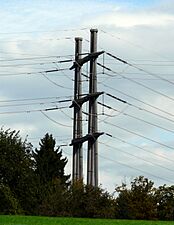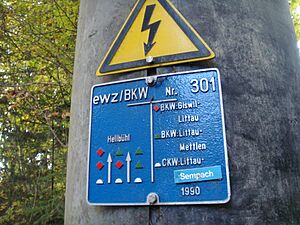Littau facts for kids
Quick facts for kids
Littau
|
||
|---|---|---|
 |
||
|
||
| Country | Switzerland | |
| Canton | Lucerne | |
| District | Lucerne | |
| Area
Lua error in Module:Wd at line 1575: attempt to index field 'wikibase' (a nil value).
|
||
| • Total | Lua error in Module:Wd at line 1,575: attempt to index field 'wikibase' (a nil value). km2 (Formatting error: invalid input when rounding sq mi) | |
| Elevation | 511 m (1,677 ft) | |
| Population
(2018-12-31)Lua error in Module:Wd at line 1575: attempt to index field 'wikibase' (a nil value).
|
||
| • Total | Lua error in Module:Wd at line 1,575: attempt to index field 'wikibase' (a nil value). | |
| Demonym(s) | Littauer | |
| Time zone | UTC+01:00 (Central European Time) | |
| • Summer (DST) | UTC+02:00 (Central European Summer Time) | |
| Postal code(s) |
6014
|
|
| SFOS number | Lua error in Module:Wd at line 1575: attempt to index field 'wikibase' (a nil value). | |
| Surrounded by | Emmen, Kriens, Lucerne (Luzern), Malters, Neuenkirch | |
| Website | Profile , SFSO statistics |
|
Littau was once a separate town, or municipality, in Switzerland. It was located in the canton of Lucerne, which is like a state or region. On January 1, 2010, Littau officially joined the bigger city of Lucerne. So, now it is a part of Lucerne.
Contents
History of Littau
Littau was first mentioned in old records way back in 1178. Its name then was Litowo. For many centuries, it was its own community. However, on January 1, 2010, Littau merged with the city of Lucerne. This means they became one big city. The agreement for this merger said that the new, combined city would be called "Luzern."
Exploring Littau's Geography
Littau covers an area of about 13.3 square kilometers (which is about 5.1 square miles). A big part of this land, about 52%, is used for farming. Forests cover about 21% of the area. The rest of the land, about 25%, has buildings and roads. A small part, less than 2%, is made up of rivers or other natural areas.
The former town is located on both sides of the Kleine Emme river. It grew from four different parts. These parts each had their own unique landscape and history. They were the main village of Littau, Niederlittau and Littauerboden, the farmhouses in the Littauerberg area, and finally Reussbühl and Ruopigen.
People and Life in Littau
In 2009, Littau had a population of 17,224 people. About 36.6% of the people living there were from other countries. Over the ten years before 2009, the number of people living in Littau grew by about 6.1%.
Most people in Littau speak German, which is about 75.6% of the population. Italian is the second most common language, spoken by about 6.2% of the people. Serbo-Croatian is the third most common, spoken by about 6.0%.
In the 2007 elections, the most popular political party was the SVP. They received about 29.5% of the votes. Other popular parties included the CVP (26.5%), the FDP (21%), and the SPS (14.3%). These parties represent different ideas about how the government should run.
When looking at age groups, about 22.6% of the people were young, aged 0–19 years old. About 29.5% were young adults, aged 20–39 years old. The largest group, about 34.3%, were adults aged 40–64 years old. Older adults, aged 65 and above, made up about 13.7% of the population.
Many people in Switzerland are well-educated. In Littau, about 56.4% of adults (aged 25-64) have completed either a non-mandatory upper secondary education or have gone on to higher education, like a university.
In 2005, about 162 people worked in farming and related businesses. About 2,189 people worked in factories and manufacturing. The largest number, about 3,532 people, worked in service jobs, like shops, offices, and healthcare. In 2000, about 53.9% of the people in Littau had a job. Also, about 44% of the workers were women.
In 2000, most people in Littau were Roman Catholic (63.7%). About 10.3% were Protestant. Other Christian faiths made up about 6.06%. There were also about 7.97% of the population who were Muslim. A small number of people belonged to other religions, or did not follow any religion.
The table below shows how Littau's population grew over many years:
| Year | Population |
|---|---|
| around 1695 | c. 500 |
| 1798 | 668 |
| 1816 | 1,066 |
| 1850 | 1,314 |
| 1900 | 3,699 |
| 1950 | 5,644 |
| 1960 | 8,715 |
| 1970 | 13,495 |
| 2000 | 15,929 |
Cool Places to See
One interesting fact about Littau is that it has part of the world's tallest pylon (a tall tower that holds up power lines) made of special concrete. This pylon, called pylon 301, was built in 1990. It stands about 59.5 meters (or 195 feet) tall! It is part of a power line that goes from Innertkirchen to Littau and then to Mettlen.
- Pylon 301
See also
 In Spanish: Littau para niños
In Spanish: Littau para niños












